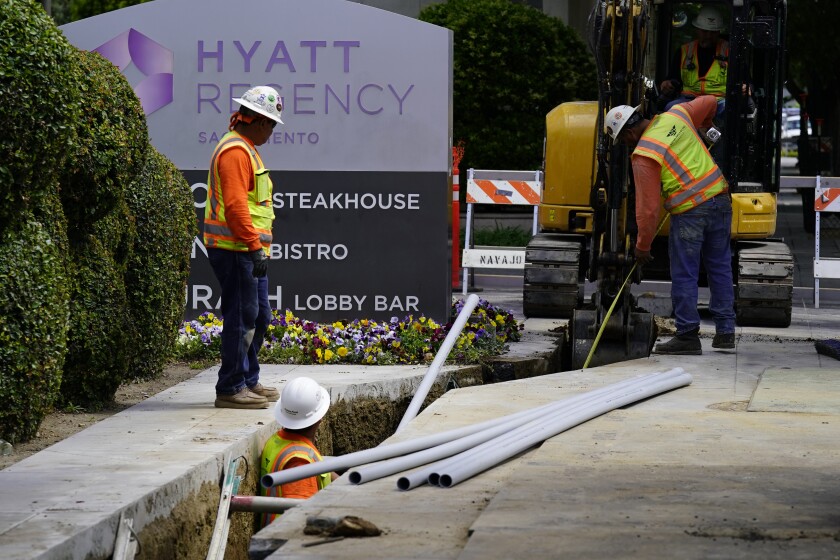https://www.latimes.com/business/story/2022-04-21/california-set-to-keep-workplace-pandemic-rules-through-2022
California will keep workplace pandemic rules through 2022

California workplace regulators on Thursday extended mandatory pay for workers affected by the coronavirus through the end of 2022, acting more than two months after state lawmakers restored similar benefits through September.
The decision again pitted management against labor as the Occupational Safety and Health Standards Board renewed revised workplace safety rules that would otherwise have expired in early May.
“I don’t think we’re done with this yet,” board Chairman David Thomas said of the pandemic.
“There’s going to be a surge in a week or so,” Thomas added. “This is the best … protection we have.”
Laura Stock, an occupational safety representative on the board, echoed employee advocates who lobbied board members to continue special protections for workers even as health officials ease mask, quarantine and other requirements for the general public.
Unlike members of the public who can choose their own risk tolerance, Stock said, “people who are in the workplace … have no choice but to be there.”
Management representative Kate Crawford said the rules have caused confusion as she cast the only “no” in a 6-1 vote.
Keeping what is known as “exclusion pay” for workers who are sent home due to the coronavirus is both costly and confusing, particularly since the Legislature recently approved COVID-19 sick leave, said Rob Moutrie, a policy advocate with the California Chamber of Commerce.
Small businesses in particular have struggled with the obligation, Moutrie said. The California Occupational Safety and Health Administration rule applies in almost every workplace in the state, covering workers in offices, factories and retail businesses, while the state sick leave law applies only to companies with 26 or more employees.
The debate comes as the highly transmissible BA.2 subvariant of the Omicron variant
becomes dominant in California and across the U.S., threatening a new wave of infections.
The state’s coronavirus case rate is up by one-third and test positivity has doubled since late March. Hospitalizations and the number of intensive care patients remain at or near their lows for the pandemic. But the state’s models predict hospitalizations will increase from fewer than 1,000 now to 1,500 in another month, while ICU admissions are expected to continue declining before beginning a slow increase by late May.
The renewed workplace regulation requires employers to keep paying workers’ wages and maintain their seniority and other benefits for as long as they can’t work because of a coronavirus exposure or infection through work, unless they receive disability payments or the employer can prove the close contact wasn’t work related.
“It is important that employees who are COVID-19 cases do not come to work,” Cal/OSHA said. “Maintaining employees’ earnings and benefits as usual, when they are excluded from the workplace, is important to ensure that employees will notify their employers if they test positive for COVID-19 or have a close contact.”
The state’s sick leave law differs in that it provides employees with up to one week of paid time off if they get the coronavirus or are caring for a sick family member. They qualify for a second week off only if they or their family members test positive.
There’s a troubling provision in the revised Cal/OSHA paid leave rules that isn’t in current regulations, said Mitch Steiger, a legislative advocate for the California Labor Federation.
Currently, employees who have had close contact with an infected co-worker are also sent home, with pay. But under the revised rules they could not stay home until they test positive.
“The employer could force that person to stay at work and interact with co-workers, members of the public and immunocompromised people and whomever until that person tests positive,” Steiger said before the board’s decision.
“The more that we walk that back, the more space we give the virus to spread,” he said.
Agribusiness representatives objected that the workplace rules give employers two choices when dealing with an outbreak of three or more coronavirus cases if an employee comes in close contact. The employee must either test negative, or be given a week off with pay if they decline to be tested.
“You’re encouraging people to not get tested,” Michael Miiller, California Assn. of Winegrape Growers’ government relations director, told the board.
California has recently eased many masking and quarantine rules. Cal/OSHA says most of the revised regulations are consistent with recommendations and orders from the California Department of Public Health that employers are already following.
Stephen Knight, executive director of Worksafe Inc., an Oakland-based worker advocacy group, is concerned that Cal/OSHA is now relying too heavily on recommendations for the general public instead of those designed specifically for workplaces.
There’s a difference, he said, “between families choosing to go out to dinner, and a family member having no choice but to clock in and stand shoulder-to-shoulder washing dishes.”

댓글 없음:
댓글 쓰기